TESTIMONIAL: KAIPO CHE! RESIDENCY
I have participated in many residencies, international and national but this has been the best. This was my first trip to India.
I was interested in this project as I have always admired Indian art and culture, in particular Indian miniatures, the wonderful rich textiles, the carvings of Islamic art and the wonderful imagery found in Hindu temples. During the residency I have seen first hand traditional art and architecture as well as contemporary art.
One of the aims of the residency was to make drawings for a group show at the Arts Centre. I was inspired by the landscape and able to work in the lovely studio with a mix of Indian music playing in
the background.
The kite flying festival was a joy and we were welcomed on to the terraces in many different places to join in the celebrations. All my senses were alive as the music, colours, the tug of the kites and the
smell of spices filled the air. The imagery will fuel my imagination for years to come.
Speaking to the artists from Baroda has been inspirational and there was a remarkable chemistry in the group. We became a “family” in a short space of time.
I felt very privileged to participate in this residency where I gained a real insight to the culture and art in Baroda. This was not from a tourist’s viewpoint but from the perspective of artists living and
working in the city.
The residency was well organised and I would not hesitate in recommending the project to other artists.
REPORT:
Despite my worries about jet lag I managed to get up on the first day, Thursday 4 January at 7:30am feeling fairly fresh. The accommodation was simple and perfect. Food was delicious and I enjoyed
most offerings. I thought my waistline would expand as I ate so much, but surprisingly I didn’t gain any weight.
4- 5 January
The first day was spent getting our bearings and with introductions to artists and people involved in the residency. It was apparent that food and chai were going to play a big part in the bonding of the
group. We received the warmest of welcomes from the artists and the curator, Bakulesh.
Practical issues such as studios were sorted and materials were given out. Any shortfall was dealt with by a trip into the local art shop. This was my first experience in a tuk tuk.
My proposal to make a 2m drawing was abandoned in favour of making smaller pieces. This was for a number of practical reasons such as space and the availability of materials. The quality of the inks
was different to those I use in the UK but I am used to adapting so it wasn’t an issue.
My intention to respond to the local landscape began with a series of observational drawings in my sketchbook over two days.

Sketchbook study
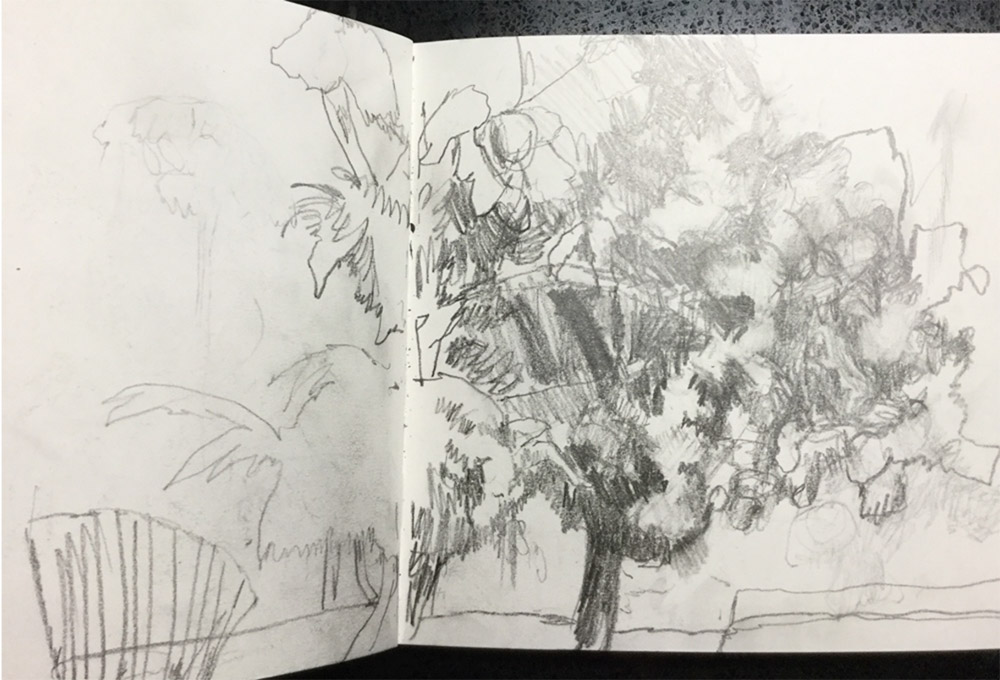
It was clear from day one that we were going to be participating in lots of activities and experiences whilst preparing for the exhibition and so I had to focus on my work s much as possible when I had the opportunity. At first I was worried that time would be too fragmented to make drawings. But I also knew that exploring Baroda would feed my work too. In any event the balance was perfect! And whilst the Reliance Township was idyllic it was great to explore the colours, textures, sounds and smells of Baroda. Also making time to talk to the other artists over chai and mealtimes meant we all gained insights into each other’s practice.
After the observational drawing I closed the sketchbook and worked from imagination. Using broad brushes lightly loaded with ink I made a start on the finished pieces. I usually use clouds in compositions as a tool to take the viewer round the picture. However, there is a distinct lack of clouds this time of the year in Baroda. Also, the landscape is fairly flat and using steps and slopes as a way of navigating the picture was not an option. I elected to use different plains with pattern and marks to divide the space.
I felt more confident about the work when Bakulesh approached me about swapping our drawings. So now I have a beautiful drawing and a piece of my work hangs in his home.
 Drawing for Bakulesh
Drawing for Bakulesh
One problem I had was connecting to the internet as my phone was not unlocked. Zahir tried to sort it on a number of occasions. As there was no WiFi at the township I relied on pairing my phone with
Caroline. Whilst this wasn’t perfect it enabled me to keep in touch with family back home. The phone was eventually unlocked via my account and the sim supplied by Artcore worked perfectly. It was a thoughtful gesture to supply and sort out the sim and much appreciated.
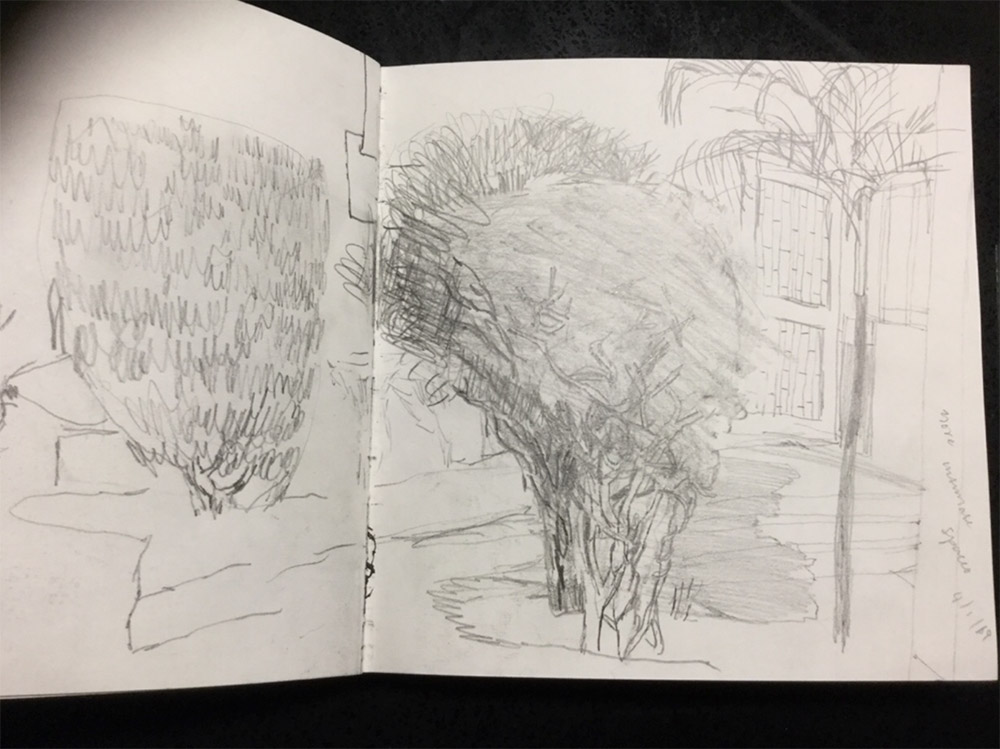
Sketchbook study
One of the highlights of the residency was the garba dancing on the evening of 5th January. Shilpa (wife of Bakulesh) supplied a choice of skirts and tutoring. I wasn’t the most elegant and coordinated
but I loved it. The music, rhythms and joy of dancing made it a wonderful experience which I later captured in a number of drawings and collages.

One of three A4 drawings inspired by the garba dancing
6th January
As well as making 2 large drawings/collages (63 x 88cm) I worked on smaller pieces in my room at the guest house. I was aware that time at the Arts Centre might be limited by the opening hours( 10 – 8) and the frequent visits to various places. And of course the lovely lunches and breaks were also important “interruptions”.
For example we had the opportunity to visit the exhibition by Kirit Jhaveri at the gallery of the Faculty of Fine Arts, MS University where we saw woven canvas paintings. I found the show a bit mixed and I was surprised at the low quality of the presentation. However, I later saw a show in the same space exploring technology which was both engaging and beautifully presented .
7th January – International kite festival
I initially decided that I would stay at the camp rather than go to the international kite festival. I wanted to continue with my drawing. I am so glad I changed my mind! The colour, music and festival atmosphere made it a day to remember. I am easily seduced by colour and I was totally entranced by blue sky and the dancing kites.

The visual feast was further enhanced by the amazing young dancers performing on stage. Any hope of recording the spectacle was abandoned when curious visitors and the press wanted to interview us or take selfies. I managed a few marks but nothing of significance. However, the experience remains etched in my imagination.
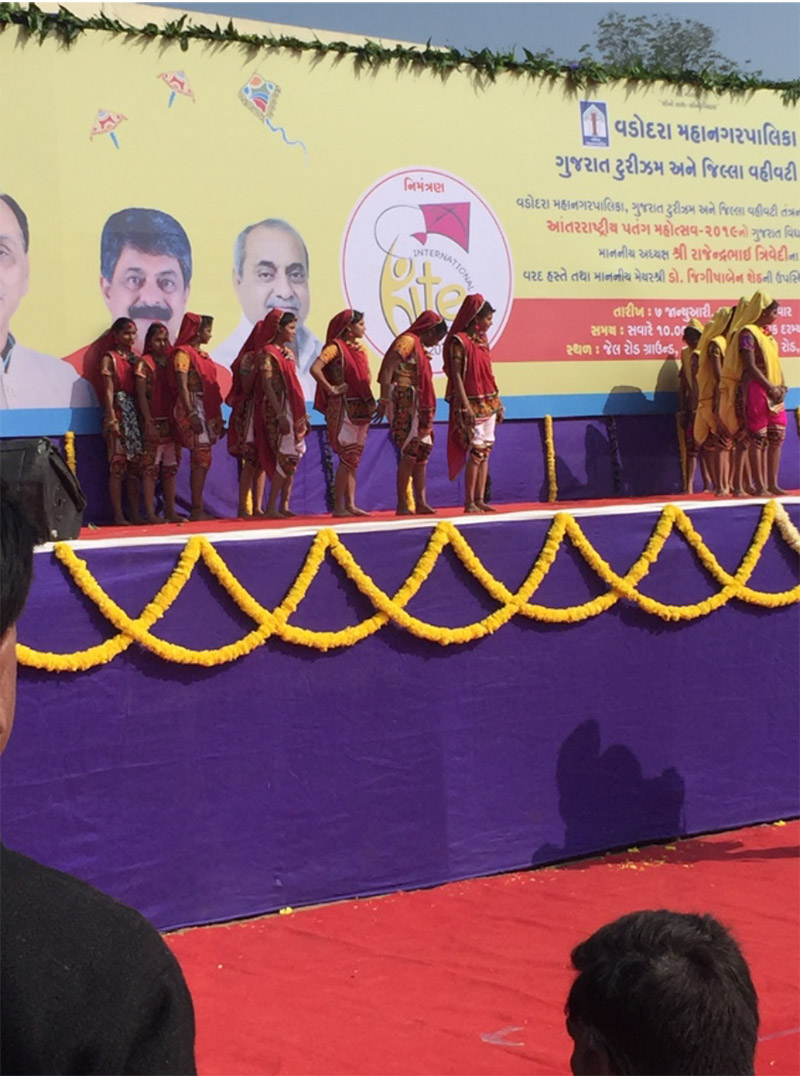
8 January – Temple and artist presentations
A walk to the local temple before 10 o’clock to see close up the building we passed every day to the Reliance Centre. I was interested in the iconography and the storytelling.

Later we listened to presentations by the Indian artists at the Arts Centre. I felt there were connections between my work and many of the other artists. I enjoyed the painterly qualities combined with more graphic detailed elements of paintings by Debashish Dutta which connected with my own work. Our paintings also show people often together but seemingly unconnected. We had some interesting conversations. I was also drawn to Arunan’s paintings. His colour palette is beautiful. I love the decorative elements which draw the viewer to the darker content. Sometimes the imagery is personal and he showed us work where he used his mother’s rug as a canvas.
9 January
The presentations at the university gave artists in India and students an insight into our work. It would have been impossible make an oil painting which take months to develop so it was good to talk about these pieces. I had lots of conversations after the talks as it gave a much more rounded picture of my practice.
10 January
A visit to the Lakshmi Villas Palace, Baroda with the audio tour. The audio was perfectly paced and gave us background information about this amazing residence. It was good to see the fusion of Indian and European architecture. I was particularly drawn to the Belgium stained glass windows and the intricate carvings. I continued to work on my finished pieces, making decisions about the framing, opting for a simple contemporary white box frame.
11 January – Khambhat
A road trip to the Jami Masjid mosque at Khambhat with the Residency artists also stopping at the farmhouse belonging to Shilpa’s uncle. I sat next to Sachin Karne who filled me in with interesting facts about the tobacco industry and the fruit being sold on the roadside.
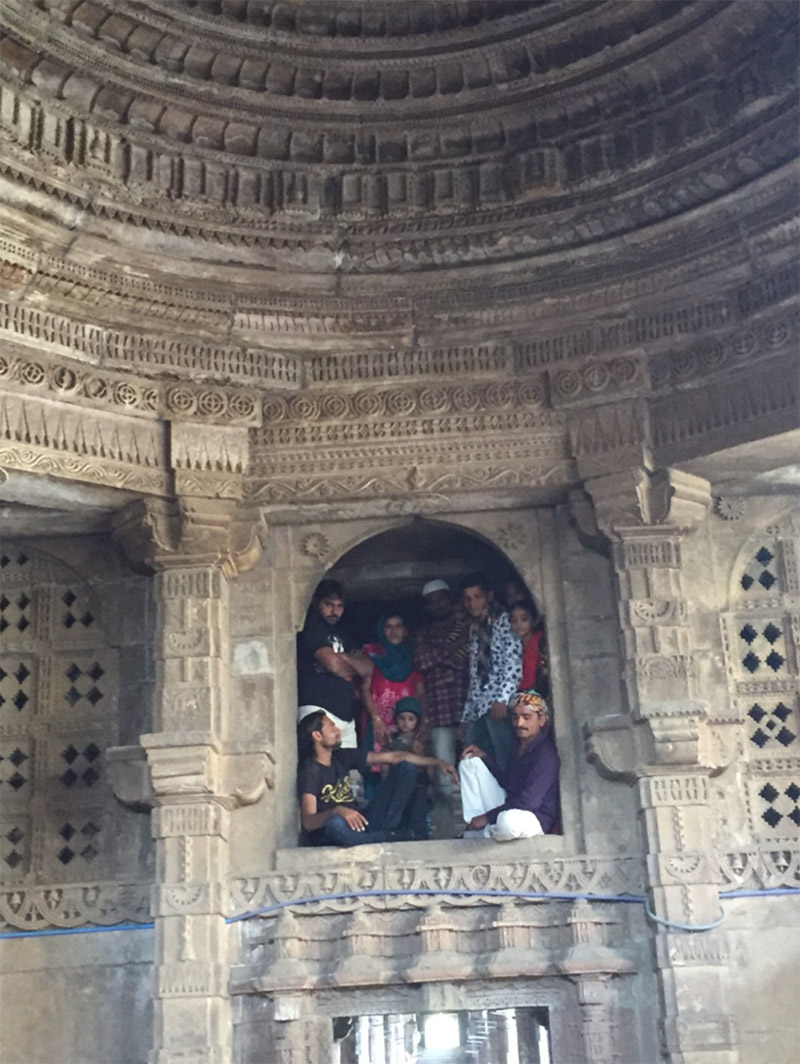
My current work involves a fusion of different architecture and this mosque provides wonderful imagery to feed my imagination.
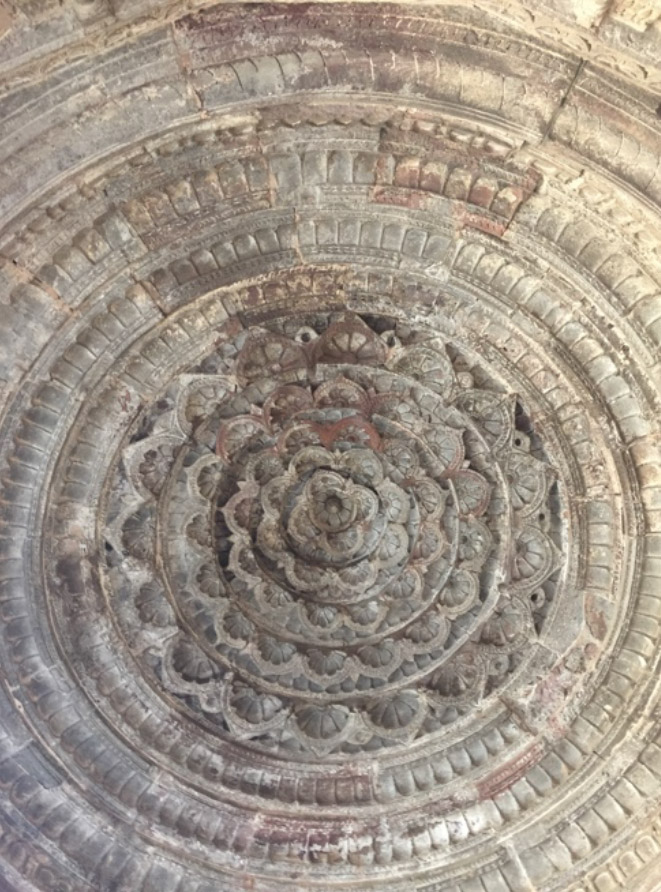
We also visited the town of Khambhat where we visited a kite warehouse. I could feel the excitement growing for the kite festival. The streets of the town were filled with colour. The kites and strings of neon, the locals wearing traditional clothing were adding to the rich palette I associate with India. All my senses tingled – the sounds of horns, the colours of the market, the smell of spices, the heat on my back and the taste of sweets from a renowned shop.
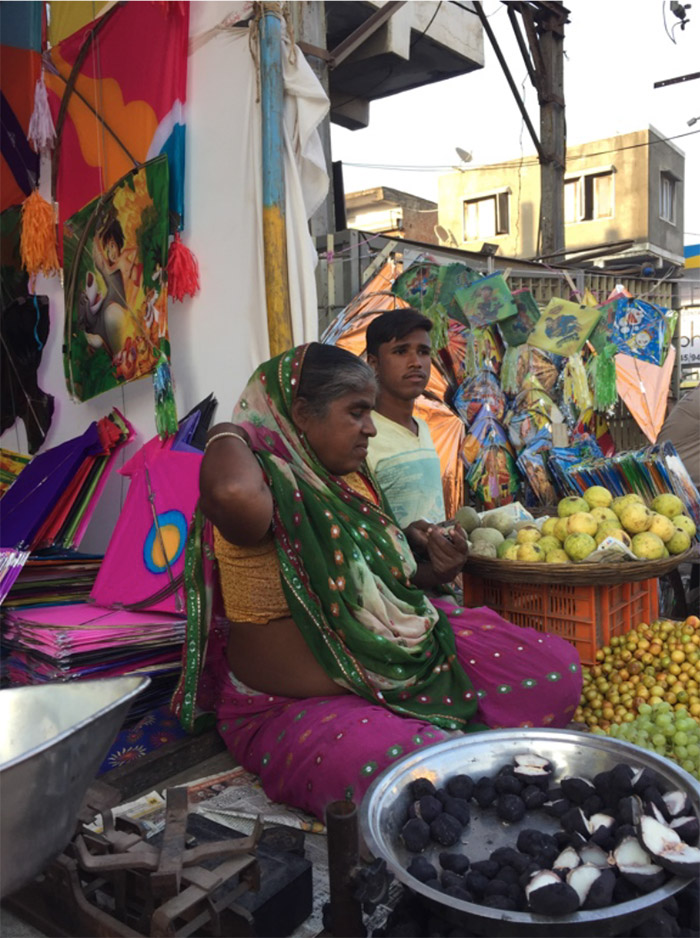
12 January
With little time until the exhibition I prepared a short statement about my new piece and a statement about my general practice. The title “Before the Owlets” refers to the location where I first started drawing in my sketchbook. Little did I realise at the time that it was close to an owl’s nest.
I had been asked to contribute to a group mural where I drew a tree to be filled in black. A young intern, Purva was given the task of painting the drawings. There is a tradition of mural paintings in Baroda so it was great to contribute.
13 January
The day of the preview! The frame for the second drawing did not arrive in time for the show and in any event the space would have been too crowded. Instead it was arranged on a table with preparatory drawings and sketchbooks for visitors. The sketchbooks proved to be a success and provided a talking point with guests. Students in particular were interested as they provide an insight into my practice.
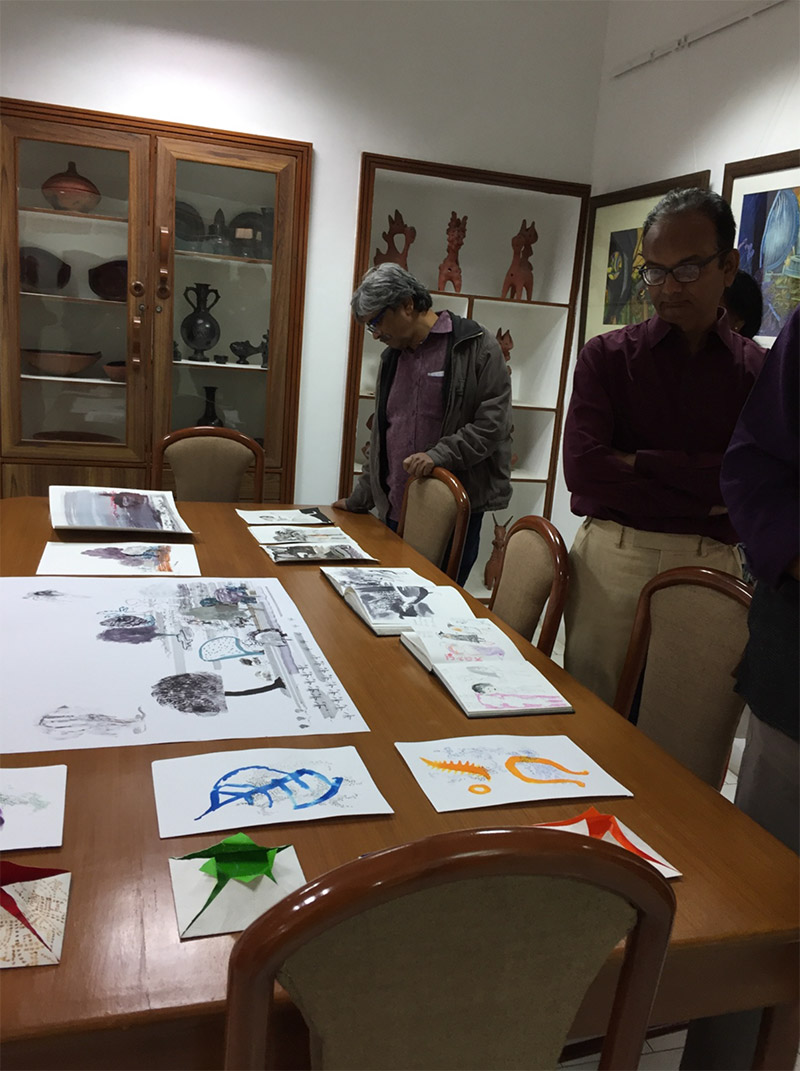

After the Owlets
14 – 15 January
Kaipo Che! The kite flying festival had arrived and as anticipated it was amazing. With a sugar rush and adrenaline fired it was a packed two days. Through Caroline’s interest in the kite strings and Phil and Huw’s research I was given a different perspective of the festival. The dark side was ever present and the dangers of glass infused strings to people and birds was evident in the news stories that followed. However, the feeling of freedom and the rhythmic tugs on the kites as I endeavoured to reach new heights was exhilarating. The beat of the music enhanced the experience. Sweets and drinks were generously shred by the hosts and we were welcomed wherever we went. We visited three different terraces on the first day. Zahir was risk averse and was alert to the dangers of one terrace without barriers on the boundaries. But as it was a large terrace we were able to fly kites with a wide buffer and watch with excitement as the duals and the kite cutting took place. Being on the terraces we were able to witness the city from a different perspective. This was also interesting for future paintings.

16 -18 January
The next stage of the residency was designed for Caroline and me to sort out our own itinerary . We were keen to take up the offer to visit artist’s studios, including those of Sachin, Arunanshu and Bakulesh. It was interesting to see how they not only survived as an artist but made a really good living. In the midlands it is difficult to recall artists living so well from their practice with such amazing workspaces. The Indian artists we met seem to be supported by a number of collectors and regularly show work in Delhi and Mumbai.
We also visited a textile factory where a block printer kindly demonstrated his skills on paper for us.
It was a privilege to watch the craftsman at work. As I use pattern in my work it was something I was particularly keen to visit.
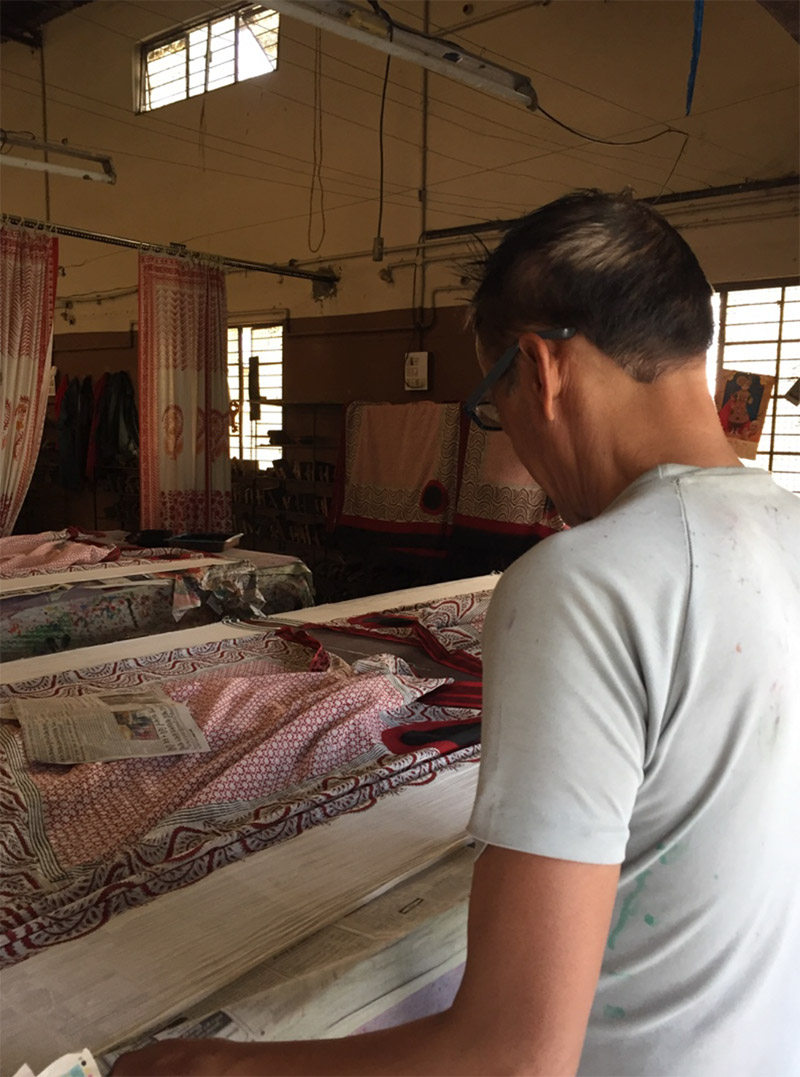
A visit to newly established Gallery White was a treat. #deathofcommonsensense was a witty and well curated show. In particular I enjoyed ‘The Reiterators’ by Katyayini Gargi, a looped animation of various individuals contained in a cabinet/block of flats. This piece connected with my current work. Unfortunately we arrived with only 15 minutes until closure but I loved every minute.

The Reiterators’ by Katyayini Gargi, looped animation, 2015
The Reiterators’ by Katyayini Gargi, looped animation, 2015
Caroline and I visited the Baroda Museum and gardens. We hadn’t allowed enough time to do it justice but it was an amazing museum, modelled on the V and A in London. Whilst it was tired and needed an injection of cash to preserve some of the amazing exhibits, it did have a charm which is sometimes lost on our more sterile environments in the UK. There was also an abundance of Indian miniature paintings and I would have loved to spent more time here. There was also beautiful textiles, ceramics and carvings from China, Japan and Indonesia. So much to see – and that was before we explored the garden.
We later visited the fine art faculty at the university where we had a guided tour of the department by Indrapramit Ray. The spaces are really generous and the campus is beautiful.
In the afternoon we visited Zunu’s studio to see how he was reviving the art of stone inlay. He works on large commissions employing local craftsmen. He took us through the process from design, transfers and showing us the raw semi precious stones – to finished pieces. It was fascinating and I really connected with the decorative pieces.
19- 20 January
Caroline and I decided to spend an evening in Ahmedabad and explore the Sun Temple and the step well at Patin as recommended by a number of artists. The Ghandi’s Ashram was also a must. The original itinerary was trimmed to give us more time at the places mentioned. Artcore arranged for the wonderful Purva (the intern) to be our guide as she lives in the city. We were given the option to hire the driver who had previously driven us round Baroda.
The first stop was Ghandi’s Ashram. It was quite moving to be in a place where the great man himself lived in a simple dwelling. A demonstration of the hand looms used by Ghandi brought history to life.
Purva then arranged for us to be dropped off in the bustling market, a short walk away from the hotel. She took us to a beautiful but neglected temple and navigated round the colourful city . We booked into the Deewanji Ni Haveli hotel in the centre of the city. Built in the 18th century round a central courtyard it was a pleasure to stay somewhere so beautifully restored. It was a place of calm after the busy market.
The following day was an early start and a visit to the stepwell at Patan was a highlight. Built in the 11th century as a memorial to Bhima I by his wife Udayamati, it lay undiscovered for 500 years after it was flooded, only to be found and excavated in the 1980s. It is a masterpiece and I was totally overwhelmed.

We visited the Sun Temple at Modhera nearby which was built at a similar time during the reign of Bhima I. The monumental scale and intricate carving was awesome.

On our return to Baroda our hosts were Bakulesh and Shilpa who welcomed us to their home for two nights. Shilpa shared her recipe for vegan omelettes and and chai. Yum!
20 January
The visit to the statue of unity was planned by Bakulesh where we would meet 28 artists from another residency in Kutch. The artists came from all corners of the globe and some were seasoned travellers participating in many international residencies. It was interesting comparing experiences but I am absolutely sure ours could not be bettered! Both groups were provided with drawing packs by Bakulesh – including postcard size watercolour paper. I chose to focus on the visitors and found a spot in the air conditioned food court to make some quick ink drawings. I had heard so many conflicting views about the statue but it was hard to not to be saddened by the cost and we heard about the tribes who have given up their land for the project. However, it was a wonderful day and to see the huge “Gulliver” was amazing.
21 January
We managed to squeeze in a visit to the exhibition at the University (see above) and the Site art space where we were given a tour by the amazing Manish Maheshwari. He works with artists to interpret their work using eco friendly materials, often on a huge scale. I was particularly drawn to a huge shutter using transparent slides of tools as a screen. He showed us images of work made for the Pompidou Centre and other installations around the world. The current show in the gallery is curated by Rabat Gajjar and Satyajit Dave who had the brilliant idea of inviting artists to make work in a medium chosen by the curators. This would be a medium outside their comfort zone. A year was given for the project. The results were great and some the artists have chosen to continue in their new medium.
A meal with Shilpa, Inderpremit Ray, Bakulesh, Zunuu, Caroline, the driver and Zahir rounded off the amazing residency before going our separate ways to the airport. Zahir helped me to sort a hotel near the Ahmedabad airport as I had a 4:30 am start.
A few notes
This was the most amazing opportunity and I was so lucky to experience it with Caroline Mackenzie. Despite the age gap we got on really well.
The chemistry of the group was wonderful. Whilst on paper the dynamics might appear work it is. I can’t remember a single moment of irritability.
I think artists need to be adaptable but this was mentioned in the Residency Schedule. “The work schedule will be generally be quite hectic, but as is typical in India, there can be last-minute plan changes, so do not be upset or disturbed if that happens, just go with the flow.” I enjoyed the unexpected changes and learned a lot about myself in the process. I didn’t realise my batteries had so much life!



Leave a comment